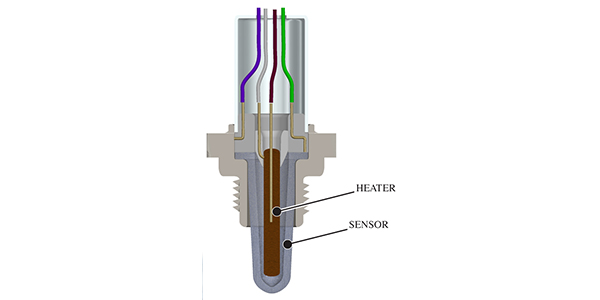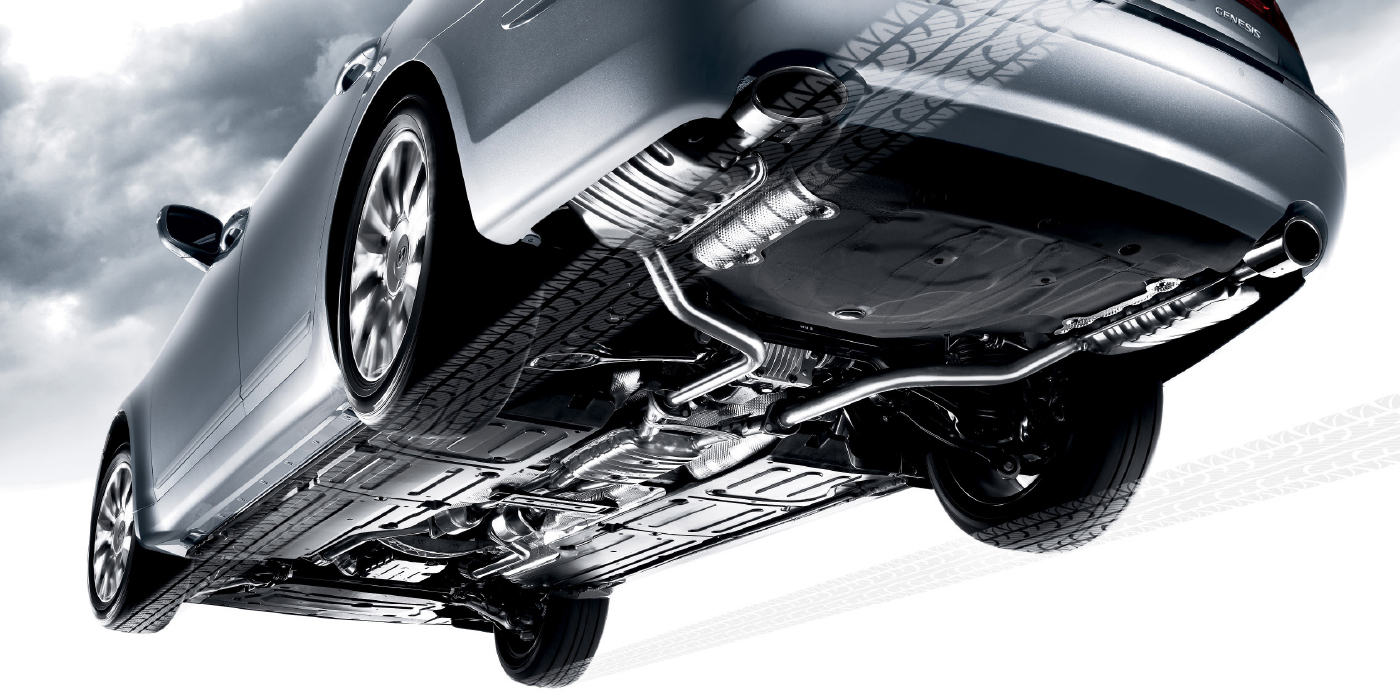r=”0″ ” align=”right” alt=”chrysler hemi “/>
1951: Chrysler begins to produce its first Hemi engine for the consumer market. The “Early Hemi,” which it was later named, used a hemispherical-shaped combustion chamber design to allow for increased airflow and better combustion efficiency. However, Chrysler discontinued the design after 1958 due to increased complexity and cost.
1954: Felix Wankel creates the first working Wankel (rotary) engine. The rotary engine includes a cocoon-shaped housing and a triangular-shaped rotor inside of it. The space between the rotor and the housing wall provides the chamber for internal combustion and the pressure of expanding gases serves to turn the rotor. For more on Rotary Engine Technology, visit underhoodservice.com and search Wankel.
1959: The VW engine is said to have inspired GM’s air-cooled, horizontally opposed, rear-mounted aluminum six-cylinder engine used in the Corvair and introduced in 1960. The GM Flat-6 engine produced 80 hp, and by the late 1960s, a 140 hp version was introduced.
GM also equipped some 1962 models with a turbocharger, one of the first American production vehicles to receive a factory-equipped turbo, providing 150 hp. Prior to its discontinuation in the late 1960s, the turbo version had grown to an output of 180 hp.
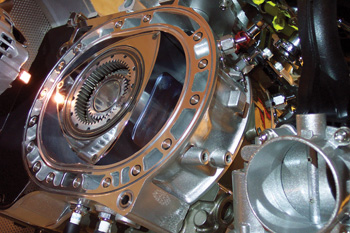 1964: Chrysler reintroduces the “Hemi” to consumers — a 426 cu. in. V8 hemispherical head-designed engine.
1964: Chrysler reintroduces the “Hemi” to consumers — a 426 cu. in. V8 hemispherical head-designed engine.
1967: The U.S. Congress passes the Clean Air Act, which authorizes planning grants to state air
pollution control agencies and begins to impact IC engine emission standards.
1975: Catalytic converters are introduced in many automobiles to meet emissions standards established by the U.S. government.
1978: The U.S. government begins limiting the amount of lead permitted in gasoline. The purpose of this regulation is to prevent deterioration of the platinum catalysts in catalytic converters. By June 1979, nearly half of all U.S. gasoline is unleaded.
1981: Cadillac introduces cylinder deactivation on its ill-fated L62 “V8-6-4” engine. Read more on variable displacement technology in this tech feature. 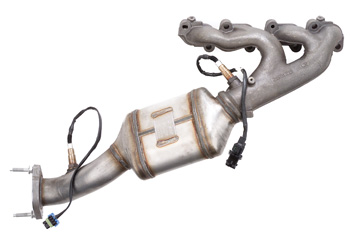
1986: The primary phase-out of leaded gasoline for passenger cars and trucks in the United States is
completed.
1997: Mitsubishi Motors America Inc. details its In-Cylinder Direct Injection Gasoline (GDI) engine. The four-cylinder engine, which earned several international awards for its ability to deliver significant improvements in fuel economy and emissions without sacrificing power, utilizes high-pressure, electromagnetic swirl injectors that spray atomized fuel directly into the cylinder into the airflow just before ignition.
Before the atomized fuel spray disperses, it vaporizes above the curved-top piston heads and is carried toward the spark plugs in an optimally stratified form. It offered 10% more output and torque, faster acceleration, and 35-40% better fuel efficiency during idling and varying speed conditions, compared to conventional multi-port injection engines.
2000: The Saab Variable Compression (SVC) engine was a development project of Saab Automobile, for which it won an award in both 2000 and 2001. 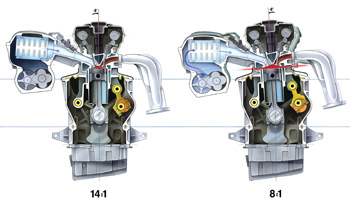
The engine used a technique that dynamically altered the volume of the combustion chamber, thus changing the compression ratio. To alter the combustion chamber volume, the SVC “lowered” the cylinder head closer to the crankshaft while running.
It did this by replacing the typical one-part engine block with a two-part block, with the crankshaft in the lower block and the cylinders in the upper portion. The two blocks are hinged together at one side.
By pivoting the upper block around the hinge point, the volume of the combustion chamber can be modified. In practice, the SVC adjusts the upper block through a small range of motion, using a hydraulic actuator.
However, General Motors shelved the SVC project, when it took over Saab Automobile, due to cost.
Duouble Dipping
The design of double (dual) overhead camshaft (DOHC) engines (below) may be older than you think.
While DOHC was used in few limited production and sports cars in the early 1920s, Alfa Romeo began using the design extensively in its vehicles by 1928. 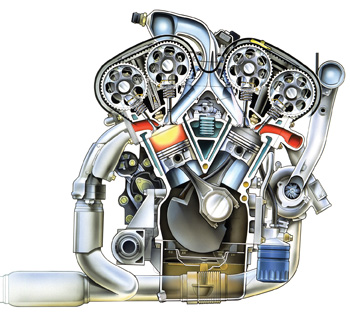
The dual camshafts allows for twice as many valves per cylinder, maximizing the engine’s output without increasing its overall volume, and has become a popular design for engines today.
Courtesy of the Computer
Of all of the changes to the IC engine, perhaps none has been credited as having the biggest impact than the engine control module (ECM). And, at times, the ECM could be credited as the component most likely to give technicians a headache.
While the main benefit from the development of the ECM was to improve performance and lower emissions for the environment, a side benefit is increased gas mileage for the driver. Of course, there are those who may not care about the environment, however, it’s doubtful that they would complain about the improved gas mileage and savings at the pump.
 ECM’s Impact on the Future
ECM’s Impact on the Future
The ECM will continue to evolve in its importance and its ability to improve emissions levels. In fact, as of this writing, the Obama administration was calling for first-ever mileage and emissions standards for big rigs and work trucks. On May 21, President Obama signed an order seeking to limit pollution from the large
vehicles.
According to the Union of Concerned Scientists, large trucks represent only 4% of all vehicles on U.S. highways, but use more than 20% of on-road transportation fuels. Obama said he wants new fuel/emission standards developed for these vehicles beginning in the 2014 model year, and lasting through 2018.
In April, the Obama administration rolled out improved standards for cars and light trucks for the 2012-’16 model years with a goal of reaching a fleet average of 35.5 mpg by 2016, nearly 10 miles per gallon more than the current average. New, additional standards will be developed further into the future. It would appear that the ECM will really have its work cut out for it in the next decade.
What is your favorite contribution or design improvement to the internal combustion engine? E-mail your thoughts and photos to [email protected].

